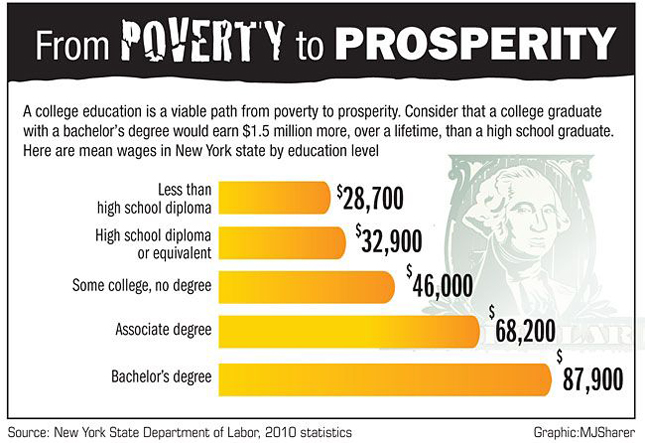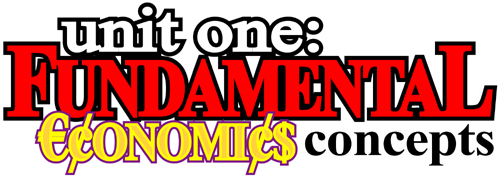Goods, Services, and Consumers
Economic products are goods or services that are useful,
relatively scarce, and transferable.
Economics is concerned with economic products—goods and
services that are useful, relatively scarce, and transferable to others.
Economic products help us satisfy our wants and needs. Because they
are both scarce and useful, they command a price.
Goods
There are different types of economic products.
The first one is a good—a useful, tangible item, such as a book,
car, or compact disc player, that satisfies a want. When manufactured
goods are used to produce other goods and services, they are called capital
goods. An example of a capital good would be a robot welder in a
factory, an oven in a bakery, or a computer in a high school. Goods
intended for final use by individuals are consumer goods.
good
tangible economic product that is useful, relatively
scarce, and transferable to others
consumer good
good intended for final use by consumers rather than
businesses

Any good that lasts three years or more when used on a
regular basis is called a durable good. Durable goods include
both capital goods, such as robot welders, and consumer goods, such as
automobiles. A nondurable good is an item that lasts for fewer
than three years when used on a regular basis. Food, writing paper,
and most clothing items are examples of nondurable goods.
durable good
a good that lasts for at least three years when used
regularly
nondurable good
a good that wears out or lasts for fewer than three
years when used regularly
Services
The other type of economic product is a service,
or work that is performed for someone. Services include haircuts,
home repairs, and forms of entertainment such as concerts. They also
include the work that doctors, lawyers, and teachers perform. The
difference between a good and a service is that a good is tangible, or
something that can be touched, while a service is not.
service
work or labor performed for someone
Consumers
Consumers are the people who use goods and services to
satisfy their wants and needs. As consumers, people indulge in consumption,
the process of using up goods and services in order to satisfy wants and
needs.
How are goods, services, and
consumers related?
REVIEW & DO
NOW
Answer the following questions: |
| What is a good?
What is a consumer good? |
|
| What is the difference between a durable good
and a nondurable good?
What is a service? |
|
|
|
Value, Utility, and Wealth
The value of a good or service depends on its scarcity
and utility.
In economics, value refers to a worth that can be expressed
in dollars and cents. Why, then, does something have value, and why
are some things more valuable than others? To answer these questions, it
helps to review a problem Adam Smith, a Scottish social philosopher, faced
back in 1776.
The Paradox of Value
Adam Smith was one of the first people to describe how
markets work. He observed that some necessities, such as water, had
a very low monetary value. On the other hand, some non-necessities,
such as diamonds, had a very high value. Smith called this contradiction
the paradox of value. Economists knew that scarcity was necessary
for something to have value. Still, scarcity by itself could not
fully explain how value is determined.
paradox of value
apparent contradiction between the high monetary value
of a nonessential item and the low value of an essential item
Utility
It turned out that for something to have value, it must
also have utility, or the capacity to be useful and provide satisfaction.
Utility is not something that is fixed or even measurable, like weight
or height. Instead, the utility of a good or service may vary from
one person to the next. One person may get a great deal of satisfaction
from a home computer; another may get very little. One person may
enjoy a rock concert; another may not.
utility
ability or capacity of a good or service to be useful
and give satisfaction to someone
Value
For something to have monetary value, economists decided,
it must be scarce and have utility. This is the solution to the paradox
of value. Diamonds are scarce and have utility, thus they possess
a value that can be stated in monetary terms. Water has utility but
is not scarce enough in most places to give it much value. Therefore,
water is less expensive, or has less monetary value, than diamonds.
The emphasis on monetary value is important to economists.
Unlike moral or social value, which is the topic of other social sciences,
the value of something in terms of dollars and cents is a concept that
everyone can easily understand.
value
monetary worth of a good or service as determined
by the market
Wealth
In an economic sense, the accumulation of products that
are tangible, scarce, useful, and transferable from one person to another
is wealth. A nation’s wealth is comprised of all tangible
items—including natural resources, factories, stores, houses, motels, theaters,
furniture, clothing, books, highways, video games, and even basketballs—that
can be exchanged.
While goods are counted as wealth, services are not, because
they are intangible. However, this does not mean that services are
not useful or valuable. Indeed, when Adam Smith published his famous
book The Wealth of Nations in 1776, he was referring specifically to the
abilities and skills of a nation’s people as the source of its wealth.
For Smith, if a country’s material possessions were taken away, its people,
through their efforts and skills, could restore these possessions.
On the other hand, if a country’s people were taken away, its wealth would
deteriorate.
wealth
sum of tangible economic goods that are scarce, useful,
and transferable from one person to another
How are value and utility related?
REVIEW & DO
NOW
Answer the following questions: |
| What is the paradox of value?
What is utility? |
|
| What is meant by value?
What is wealth? |
|
|
|
The Circular Flow of Economic Activity
The economic activity in markets connects individuals
and businesses.
The wealth that an economy generates is made possible
by the circular flow of economic activity. The key feature of this
circular flow is the market, a location or other mechanism that
allows buyers and sellers to exchange a specific product. Markets
may be local, national, or global—and they can even exist in cyberspace.
market
meeting place or mechanism that allows buyers and
sellers to come together
Factor Markets
As shown in Figure 1.3, individuals earn their incomes
in factor markets, where the factors of production are bought and
sold.
This is where entrepreneurs hire labor for wages and salaries,
acquire land in return for rent, and borrow money. The concept of
a factor market is a simplified but realistic version of the real world.
For example, you participate in the factor market when you work and sell
your labor to an employer.
factor market
market where the factors of production are bought
and sold

Product Markets
After individuals receive their income from the resources
they sell in a factor market, they spend it in product markets.
These are markets where producers sell their goods and services.
Thus, the wages and salaries that individuals receive from businesses in
the factor markets returns to businesses in the product markets.
Businesses then use this money to produce more goods and services, and
the cycle of economic activity repeats itself.
product market
market where goods and services are bought and sold
What roles do factor markets
and product markets play in the economy?
REVIEW & DO
NOW
Answer the following questions: |
| What is a market?
What is a factor market? |
|
| What is a product market? |
|
|
|
Productivity and Economic Growth
A nation’s economic growth is due to several factors.
Economic growth occurs when a nation’s total output
of goods and services increases over time. This means that the circular
flow becomes larger, with more factors of production, goods, and services
flowing in one direction and more payments in the opposite direction.
Productivity is the most important factor contributing to economic growth.
economic growth
increase in a nation’s total output of goods and services
over time
Productivity
Everyone in a society benefits when scarce resources are
used efficiently. This is described by the term productivity,
a measure of the amount of goods and services produced with a given amount
of resources in a specific period of time.
Productivity goes up whenever more can be produced with
the same amount of resources. For example, if a company produced
5,000 pencils in an hour, and it produced 5,100 in the next hour with the
same amount of labor and capital, productivity went up. Productivity
is often discussed in terms of labor, but it applies to all factors of
production.
productivity
measure of the amount of output produced with a given
amount of productive factors
Investing in Human Capital
A major contribution to productivity comes from investments
in human capital, the sum of people’s skills, abilities, health,
knowledge, and motivation. Government can invest in human capital
by providing education and health care. Businesses can invest in
training and other programs that improve the skills of their workers.
Individuals can invest in their own education by completing
high school, going to technical school, or attending college. The
chart below shows that investments in education can have substantial payoffs.
According to the table, high school graduates earn substantially more than
nongraduates, and college graduates make even more than high school graduates.
Educational investments require that we make a sacrifice today so we can
have a better life in the future, and few investments generate higher returns.
human capital
sum of people’s skills, abilities, health, knowledge
and motivation

Division of Labor and Specialization
Division of labor and specialization can improve productivity.
Division of labor is a way of organizing work so that each individual
worker completes a separate part of the work. In most cases, a worker
who performs a few tasks many times a day is likely to be more proficient
than a worker who performs hundreds of different tasks in the same period.
Specialization takes place when factors of production
perform only tasks they can do better or more efficiently than others.
The division of labor makes specialization possible. For example,
the assembly of a product may be broken down into a number of separate
tasks (the division of labor). Then each worker can perform the specific
task he or she does best (specialization).
One example of the advantages offered by the division
of labor and specialization is Henry Ford’s use of the assembly line in
automobile manufacturing. Having each worker add one part to the
car, rather than a few workers assembling the entire vehicle, cut the assembly
time of a car from a day and a half to just over 90 minutes—and reduced
the price of a new car by more than 50 percent.
division of labor
division of work into a number of separate tasks to
be performed by different workers
specialization
assignment of tasks to the workers, factories, regions,
or nations that can perform them more efficiently
Economic Interdependence
The U.S. economy has a remarkable degree of economic
interdependence. This means that we rely on others, and others
rely on us, to provide most of the goods and services we consume.
As a result, events in one part of the world often have a dramatic impact
elsewhere.
This does not mean that interdependence is necessarily
bad. The gains in productivity and income that result from specialization
almost always offset the costs associated with the loss of self-sufficiency.
economic interdependence
mutual dependency of one person’s, firm’s, or region’s
economic activities on another’s
What role does specialization
play in the productivity of an economy?
REVIEW & DO
NOW
Answer the following questions: |
| What is meant by economic growth?
What is productivity?
What is human capital? |
|
| What is division of labor?
What is specialization?
What is economic interdependence? |
|
|
|
|



